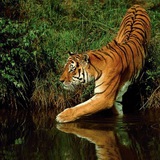
Telegram-канал wildlifen - Wildlife
 19368
19368
Join us as we explore the wilderness and share the beautiful scenery of nature! For all questions: @magellanvs

 19368
19368
Join us as we explore the wilderness and share the beautiful scenery of nature! For all questions: @magellanvs

Bears only seem clumsy. At short distances, they are able to reach speeds of up to 55 km/h.
Читать полностью…
Meerkats dig burrows up to 1.5 m deep or use the burrows of the African ground squirrel.
Читать полностью…
Lion cubs are born blue-eyed, and only by the age of two months the color of their eyes changes to amber or brown.
Читать полностью…
The mating dance of male yellow-bearded lapwings, during which birds imitate feeding chicks to interest potential wives.
Читать полностью…
The surprised chick does not understand why the food itself does not jump into his mouth, because that's how his mother fed him from birth.
Читать полностью…
The Siberian saber–toothed musk deer boasts excellent eyesight and hearing, which cannot be said about the sense of smell - it is less developed in the animal.
Читать полностью…
Face to face.
When the tip of a hummingbird's tongue gets into the liquid, it splits like a snake's, but not to catch odorous molecules, but to collect sweet nectar.
And the tongue itself can protrude far out of the beak thanks to the long legs of the sublingual apparatus, which wrap around the skull, just like woodpeckers

When the hotel is not like "breakfast in bed", but breakfast is still in bed 🦁
Читать полностью…
The Vancouver Island wolf Canis lupus crassodon is endemic to the Canadian island of Vancouver in the province of British Columbia. The color is gray or black. These animals lead a social lifestyle, live in flocks numbering from 5 to 35 individuals.
"We know from exhaustive DNA studies that these wolves are genetically different from their continental cousins," says Ian McAllister, an award-winning photographer who has been studying these animals for almost two decades.
"They behave differently, swimming from island to island and hunting marine animals. They are also morphologically different — smaller in size and physically different from their mainland counterparts," says McAllister.
90% of the food of sea wolves originates directly from the ocean and a fourth part is salmon.
These wolves are excellent swimmers, the record for the distance is their swim to the archipelago, located 12 kilometers from the nearest land

Despite its short legs, the wombat can reach speeds of up to 40 km/h.
Читать полностью…
Polar terns drive polar bears away from their nesting sites.
This small bird belongs to the seagulls. Body length 36-43 cm, wingspan 74-84 cm. White in color, with a black cap and a gray mantilla, a forked tail, strongly carved. In spring and summer, the beak turns red. Paws are short, which is why he walks waddling.
The Polar tern breeds in the polar regions, on the islands and peninsulas of Northern Europe, Greenland, Siberia, Alaska, Canada. But it winters in the Southern Hemisphere in the subantarctic and Antarctic waters of the Southern Ocean and its surroundings.
No, just imagine! From one pole to the other! From polar bears to penguins!
Due to these flights between the Arctic and Antarctica, the polar tern observes two summers every year (Arctic and Antarctic) and sees more daylight than any other living creature on Earth.

Drepanis coccinea belongs to the finches and is distinguished by a very long curved pink beak used for drinking nectar. They also eat small arthropods.
The body length of this bird is about 15 cm . The contrast of red and black plumage with the surrounding green foliage makes this bird (also called the scarlet honeyeater) one of the most notable native birds of Hawaii.
The bird is often mentioned in Hawaiian folklore. In the Hawaiian song "Sweet Lei Mamo" there is a line "A bird and a friend too".
But after the terrible fires that swept Hawaii this year, I have no idea if these wonderful birds have survived...

The closest relatives of bears are dogs, wolves and foxes.
Читать полностью…
The Pyrenean (Iberian) lynx Lynx pardinus differs from the ordinary lynx in a lighter color and pronounced spots, giving its color a resemblance to the color of a leopard. In winter, the fur fades and becomes thinner. It is half the size of an ordinary lynx and therefore hunts mainly small game - hares and rabbits, which make up about 90% of its diet, and only occasionally attacking baby deer.
There are very few of these stunningly beautiful animals left in the wild. Of course, huge efforts are being made to preserve and increase the population of the Spanish lynx, but according to various estimates, only about 150 adults remain in the wild.
Nowadays it is very difficult to meet the Pyrenean lynx in the wild. The main habitat is the mountainous regions of Spain. Also, a small number of individuals have been preserved in the Coto De Donana National Park.
But just 120 years ago, the habitat of the Spanish lynx was the entire Iberian Peninsula and the south of France.

Let's distract ourselves a little by looking at otters that eat shrimp.
Читать полностью…